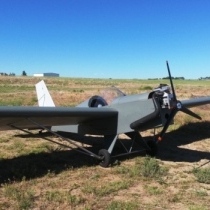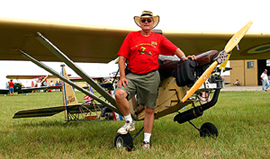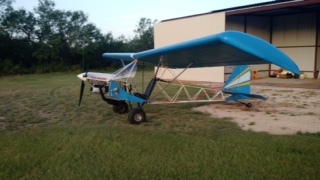|
|
 Keith103 Keith103 |
| February 14, 2019, 2:17pm |
|
 Ace Ace Posts: 632
Time Online: 13 days 6 hours 31 minutes
|
Just saw in an article linked couple days earlier in this group, to watch out before buying a used engine with prop strike history ( among other red flags listed for a used engine ).
Is a belt re-driven engine better protected against damage due to prop strike, (than an engine with direct drive like some VW's or engines with metal geared re-drive like Rotax) ? I am assuming the belt has some 'give' in it, that may save the crank-shaft and other engine parts from being impacted when prop is stopped abruptly ?
Thanks for any insight into this.
|
|
 Logged Logged |
|
|
|
|
 nathan.bissonette nathan.bissonette |
| February 14, 2019, 3:44pm |
|
 Flight Leader  Posts: 118
Time Online: 1 days 9 hours 13 minutes
|
Interesting post. The bit about "when was it last run" turns out to be important in an unexpected way.
I just got my F-33 back from Recreational Power (this is the engine that came with the Mini Max I salvaged from a barn). They said the inside was fine but the shaft coming out of the crankcase goes through a seal which, under normal operating conditions, is lubricated by oil from inside the engine. Since mine sat in the barn without running for a few years, it's possible the shaft rusted underneath the seal. If so, the rusty shaft will grind away the seal, letting in air and letting out oil. The only way to know for sure is tear the engine completely down, replacing that seal and others, which is an expensive proposition.
In my case, the news doesn't make me regret my purchase - I got a good enough deal that I can afford repairs - but it reinforces your point.
|
|
|
|
|
|
 tomshep tomshep |
| February 14, 2019, 8:52pm |
|
Ace
Posts: 446
Time Online: 28 days 19 hours 43 minutes
|
And how will you know the true answers to any of these questions? Unless you buy new, you don't. All engines are a gamble. Hear it run, if possible but, if not: check the rods are in tolerance (every ten hours) Pull the cylinders and check them for seizure and the ring grooves for stuck and coked up rings. If all good, put it in the aircraft and find out if it swings the prop as fast as it should. Then quit worrying and go flying. There are too many things that can go wrong but almost certainly won't to worry too much. It won't take more than ten minutes of taxying to know if the mill is a good 'un. |
|
|
|
|
|
 fiebichpv fiebichpv |
| February 14, 2019, 10:43pm |
|
 A/B Plans #112 has 1008 hours as of 02-09-2015 Ace Posts: 1,694
Time Online: 36 days 13 hours 14 minutes
|
My Rotax 503 engine with the B-gear box has a rubber "clutch" or drive mechanism between the prop shaft and the gearbox "driver gear" called Dog Hub Ears. It is made up of a set of two hard yet "flexible" projections that engage each other. This assembly will slip during a prop strike minimizing damage to the crank/pistons. (However I think its real function is to minimize transmission of engine vibration to the prop) I replaced that "clutch" and the circular compression springs (like huge Belview washers) during a previous rebuild several years ago. It was a precautionary maintenance item recommended by my then Rotax mechanic. Apparently this dog ear set can wear and cause engine vibration during low rpms. You will need a hydraulic press to replace the dog ears and washers.
Hope this is useful information to you Keith
Paul Fiebich |
|
|
|
|
|
 Max SSDR Max SSDR |
| February 14, 2019, 11:14pm |
|
If it flies, floats or fornicates.... rent it! Flight Leader  Posts: 181
Time Online: 3 days 18 hours 44 minutes
|
The type B gear box dampens torsional vibration via a system of bevel washers and a dog hub/dog gear arrangement. Type C gear boxes dampen torsional vibration via a rubber "Hardy Disc" rather than bevel washers. I haven't seen any rubber in a B type box? Also a carbon fibre prop can transmit far more shock than a wooden prop in a prop strike. |
|
|
|
|
|
 joe.scalet joe.scalet |
| February 15, 2019, 12:17am |
|
 Flight Leader  Posts: 155
Time Online: 2 days 1 hours 58 minutes
|
Check prop serial number against the logbook/builders log. If they are not the same consider that a prop strike occurred. There are really no trivial prop strikes. Some damage always occurs. |
|
|
|
|
|
 PUFF PUFF |
| February 15, 2019, 12:16pm |
|
 Ace Ace Posts: 1,518
Time Online: 34 days 6 hours 18 minutes
|
|
|
|
|
|
 Keith103 Keith103 |
| February 15, 2019, 4:48pm |
|
 Ace Ace Posts: 632
Time Online: 13 days 6 hours 31 minutes
|
Paul, Thanks for the response. That information surely helps.
On engines with a metal geared Prop speed reduction unit, I am wondering if there is some kind of clutch mechanism inside the engine / reduction unit, that may help reduce the full impact of the prop strike from transmitting to the crankshaft and beyond ?
I remember in old manual gear shift cars, when a learner inadvertently engages gear without pressing clutch , the vehicle used to slam forward an inch or two, before the weight and inertia of the car kills the engine instantly. This could be similar to what happens in a prop strike. Crankshafts in cars are possibly protected against such abuse, and any manual shift car would have been subjected to a few of such jolts during its lifetime.
|
|
 Logged Logged |
|
|
|
|
 tomshep tomshep |
| February 15, 2019, 8:17pm |
|
Ace
Posts: 446
Time Online: 28 days 19 hours 43 minutes
|
No. I have shattered a prop, landing a MiniMax with the gear up. The engine had to be stripped annd the hub flange was checked then the crank. It is a pressed up item on a 447 so it can distort. I spent an evening checking and re checking it on a granite surface table with the best tools an engineering company could provide out of hours. (Gauging slips to set the gap between the front bearings which I replaced, a temperature controlled oven to warm them up and an environmental test freezer to chill the crank. All done without pressing anything on.) If it is distorted, it won't spin well. Pull the plugs out and it will go over easily with a socket on the magneto nut. Tight spots ring alarm bells. |
|
|
|
|
|
 Keith103 Keith103 |
| February 15, 2019, 11:50pm |
|
 Ace Ace Posts: 632
Time Online: 13 days 6 hours 31 minutes
|
No. I have shattered a prop, landing a MiniMax with the gear up.
How can you land a MiniMax with the gear up ?I have sent you a PM. |
|
 Logged Logged |
|
|
|
|
 ITman496 ITman496 |
| February 16, 2019, 1:08am |
|
 Ace Ace Posts: 411
Time Online: 1 days 23 hours 31 minutes
|
Maybe if the gear falls off? |
|
|
|
|
|
 texasbuzzard texasbuzzard |
| February 16, 2019, 1:23am |
|
 airbike Buzzard Ace Posts: 1,238
Time Online: 8 days 23 hours 51 minutes
|
If the gear falls off then the wings will fall off too. You will break more than a prop.
Monte |
|
|
|
|
|
 ITman496 ITman496 |
| February 16, 2019, 1:27am |
|
 Ace Ace Posts: 411
Time Online: 1 days 23 hours 31 minutes
|
this is very true! But technically you could still call it a prop strike, just with a lot of other things striking the ground at the same time.  |
|
|
|
|
|
 tomshep tomshep |
| February 16, 2019, 7:28am |
|
Ace
Posts: 446
Time Online: 28 days 19 hours 43 minutes
|
The gear went up as the aircraft went down. Both wings survived, the port one needed a small repair. The struts were not so lucky.
NB. I have received the threatening and very angry PM from Keith who really does not like what I have written here and has told me to watch what I write. I therefore apologise to you all for "having an opinion on every damn' thing and just spouting crap." |
|
|
|
|
|
 ITman496 ITman496 |
| February 16, 2019, 8:56am |
|
 Ace Ace Posts: 411
Time Online: 1 days 23 hours 31 minutes
|
Do you know why the gear collapsed? I'm glad you are okay! Glad the max survived too! |
|
|
|
|
|
 tomshep tomshep |
| February 16, 2019, 10:29am |
|
Ace
Posts: 446
Time Online: 28 days 19 hours 43 minutes
|
Oh, yes! I tried to land it from six feet up and because the 'Max is a tough little bugger, I didn't end up six feet under. Too slow over the hedge on a day when I was too inexperienced on the aircraft to handle the weather conditions which were blowy. Frightened by that and not yet entirely aware of the fuel burn,which meant I wanted to get back on the ground, I let the airspeed decay too quickly while trying to keep the crosswind landing under control. I did at least land it with the wings level. The struts bent and a piece of the prop cracked the D box of the port wing and tore the fabric. The gear was scrap. Thorough checking of the wing with a camera up the inside showed that all was well and I was flying it again fifteen months later. That was five years ago. I've flown it a lot since then.
This weekend, I am fitting another 20 litres of tankage and the lower front tank will have a sight tube to count off the last ten litres, The other project, which is going well, is to fit streamlined aluminium struts and then wheel spats. I shall be installing a choke cable next weekend because the engine dies if started on the primer unless I am very lucky. MaxSSDR has suggested it will help. This will raise the potential range to around 250 miles which allows me to travel in the little aeroplane. |
|
|
|
|
|
 The Termite The Termite |
| February 16, 2019, 11:00am |
|
Ace
Posts: 588
Time Online: 5 days 3 hours 12 minutes
|
I know some folks don't have chokes(enrichment circuits) on their Rotax engines and just use the primer, but the choke makes starting far easier. Also, if you get a leak on the crankshaft seal and the engine mixture goes lean, you can use the choke to enrich the mixture and hopefully not seize the engine. However, that assumes you notice the high EGTs in time.....  |
|
|
|
|
|
 tomshep tomshep |
| February 16, 2019, 12:13pm |
|
Ace
Posts: 446
Time Online: 28 days 19 hours 43 minutes
|
Thanks Termite. I have always had difficulties getting it to run from a cold start so this looks like a good move for me. I replaced the crankshaft seals five years ago and check by pressurising the crankcase through the pump port as part of the annual check over. If it holds a couple of PSI for ten minutes, there is unlikely to be anything wrong. Loss of crankcase pressure raises EGT through lack of fuel pressure as the pump drops away, too. I know of one chap who got his Max downsafely using the primer bulb to keep the float bowl full. |
|
|
|
|
|
 Keith103 Keith103 |
| February 16, 2019, 3:17pm |
|
 Ace Ace Posts: 632
Time Online: 13 days 6 hours 31 minutes
|
No. I have shattered a prop, landing a MiniMax with the gear up.. . . . . . .
The gear went up as the aircraft went down. Both wings survived, the port one needed a small repair. The struts were not so lucky.
Gear-up or Wheels-up landing is a very specific term used in aviation, it usually means landing with the retractable gear in "up position" ( could be due to mechanical issues with the gear, or the pilot just goofed up and forgot to lower the gear ). Now, no one should be targeted just because he uses one term incorrectly. We are reasonable people and we don't usually. But when you choose words carelessly, and ad-lib on every thread, and when there is a proliferation of such replies from the same member, meaning this is becoming a pattern, then the utility of the forum to me is itself at stake. I would have liked thoughtful replies, from a diverse group of knowledgeable people, rather than most replies from just one member, so we can sustain the constructive nature of dialog on this forum. I presume the administrator will intervene if he deems it necessary. |
|
 Logged Logged |
|
|
|
|
 tomshep tomshep |
| February 16, 2019, 3:44pm |
|
Ace
Posts: 446
Time Online: 28 days 19 hours 43 minutes
|
My words are always chosen with great care. So you don't like my sense of humour. This spoils the usefulness of the forum for you.
Are you suggesting my opinions and advice are harming the constructive nature of the dialogue? I am part of the diverse group of knowledgeable people, Keith.
If you don't like that, it is your problem, not mine.
I shall continue to express myself and my know how as I always have done. You can always block my posts if you don't like them but in general, I have been made welcome here and have not only given advice and help but have received it in equal measure. Stay with it Keith, you may learn something.
For example: clutches in conventional motor cars have take up springs and the natural slippage of the clutch to eliminate any shock loading of the one piece crankshaft which is also designed with strength in mind, not necessarily weight A car engine cannot be shock loaded by anything less than a rod through the side. Aircraft engines do not have clutches as a rule.
Belt drives can still suffer shock loads but very much less so than gearboxes do . The Rotax B box has neither clutch nor rubber coupling. If you don't believe me there are plenty of exploded diagrams available. The shock load of the prop hitting the ground is enough if you are unlucky to twist a pressed up crankshaft (As is usual on two strokes,) out of true. The same has been known to happen if the mag is switched off at high RPM and then back on again, by the way.
But you still don't know if a prop strike has occurred so my opening assertion remains. Look the engine over. Do sensible checks. Fly. |
|
|
|
|
|
 Keith103 Keith103 |
| February 16, 2019, 8:41pm |
|
 Ace Ace Posts: 632
Time Online: 13 days 6 hours 31 minutes
|
Thanks, Tom. I find some useful information in your recent post.
>>>>>>>>
For example: clutches in conventional motor cars have take up springs and the natural slippage of the clutch to eliminate any shock loading of the one piece crankshaft which is also designed with strength in mind, not necessarily weight A car engine cannot be shock loaded by anything less than a rod through the side. Aircraft engines do not have clutches as a rule.
Belt drives can still suffer shock loads but very much less so than gearboxes do . The Rotax B box has neither clutch nor rubber coupling. If you don't believe me there are plenty of exploded diagrams available. The shock load of the prop hitting the ground is enough if you are unlucky to twist a pressed up crankshaft (As is usual on two strokes,) out of true. The same has been known to happen if the mag is switched off at high RPM and then back on again, by the way.
<<<<<<<<< |
|
 Logged Logged |
|
|
|
|
 Keith103 Keith103 |
| February 16, 2019, 9:00pm |
|
 Ace Ace Posts: 632
Time Online: 13 days 6 hours 31 minutes
|
Hi group,
The reason I asked this question was, I had my prop hit the dirt /grass on the side of the runway while doing fast taxiing practice couple months back. The engine stopped as a result, but when I examined the prop tip, the damage was negligible. ( Pics below of tip before damage and after damage ).
How did it happen ? I was trying to practice fast, tail up taxiing on the runway. ( This was in first week of Nov, before the weather shut down fully for the winter. ) There was a bit of cross wind from the left, no more than 5 to 7 mph, the runway was asphalt topped, and very smooth and nice ( Hudson, CO 18V ).
I opened throttle to only 5000 RPM as my intention was not to get airborne. As plane picked up a bit of speed (around 10 to 15 mph I guess), I was trying to lift the tail , and then I saw it was veering a bit to the left. I quickly closed throttle fully, tried to correct the drift with tail wheel, but forgot to bring the stick all the way back, which I realized was a big mistake. I now realize the Max tail wheel has very little traction at slow speeds, unless you keep the stick fully back.
So the Max kept going left, now less than 10 mph, but I have no brakes either. So the plane drifted more and went 5 or 6 feet off the left shoulder, by which time the main wheels got stuck in some loose dirt, the nose dipped a bit with the momentum, and the prop struck the loose dirt mound and then the plane dipped back on to the tail wheel. The tail wheel was still on the runway. But the engine had stopped.
I got out and examined the prop, and somehow got a feeling that with so little damage to the prop, the engine may not have been impacted. I restarted the engine, saw nothing visibly different from before, and taxied back to the ramp. I subsequently checked out the engine at all RPM's , and found no change in engine or prop behavior. No vibrations or change in RPMs, or anything else unusual.
So lesson I learnt was : keep the stick back till I get enough speed for rudders to become effective, and only then try to move stick forward to get tail up, if tail has not lifted up by then.
I have soloed on tail draggers but those planes were heavier ( gross 2500 lbs ).
|
|
 |
|
|
 Logged Logged |
|
|
|
|
 texasbuzzard texasbuzzard |
| February 16, 2019, 9:32pm |
|
 airbike Buzzard Ace Posts: 1,238
Time Online: 8 days 23 hours 51 minutes
|
Keith since you were near idle and the prop hit dirt and the engine ran fine after I doubt you sustained any damage to the engine. If it was me I would tether the plane and do several run ups and check for vibration and normal temps...if all is good I would go fly. Asphalt runways are not very forgiving in crosswinds and cutting the throttle took away most rudder control. Hope this helps
Monte |
|
|
|
|
|
 The Termite The Termite |
| February 17, 2019, 12:27am |
|
Ace
Posts: 588
Time Online: 5 days 3 hours 12 minutes
|
Loss of crankcase pressure raises EGT through lack of fuel pressure as the pump drops away, too. I know of one chap who got his Max down-safely using the primer bulb to keep the float bowl full.
I have an electric Facet pump inline as a backup to the "thumper" pump. Cheap insurance. And much better than a primer bulb. |
|
|
|
|
|
 ITman496 ITman496 |
| February 17, 2019, 2:13am |
|
 Ace Ace Posts: 411
Time Online: 1 days 23 hours 31 minutes
|
Termite, I plan on doing the same, how is yours plumbed in? I was going to put them in parallel since they both have check valves, sorta. The pulse pump by its nature, and the facet pump just sorta has one according to the specs. What PSI do you run on yours, btw? |
|
|
|
|
|
 Keith103 Keith103 |
| February 17, 2019, 3:07am |
|
 Ace Ace Posts: 632
Time Online: 13 days 6 hours 31 minutes
|
Monte, Thanks. I appreciate your insight and advise. |
|
 Logged Logged |
|
|
|
|
| gyrojeffro |
| February 17, 2019, 4:31am |
|
Guest User |
Look at my build log Keith, did I screw up, I sure did! If we didn't screw up we would be democrats! |
|
 Logged Logged |
|
|
|
|
 The Termite The Termite |
| February 17, 2019, 11:00am |
|
Ace
Posts: 588
Time Online: 5 days 3 hours 12 minutes
|
Termite, I plan on doing the same, how is yours plumbed in?
I ran mine in series. I used a Facet 40105 pump: 2.5-4.5 psi range, 30 gals/hr. Fuel line comes from the tank(s) to selector valve manifold, to the electric pump, to the gascolator, to the diaphragm pump, out to the dual carbs. I only run the electric pump for a few seconds to prime the system for the first start of the day, if my plane hasn't been run for several days. Other than that, it's strictly for backup. Here's a good article about fuel systems: http://www.challengers101.com/FuelSystem-AndyH.html |
|
|
|
|
|
 ITman496 ITman496 |
| February 17, 2019, 12:18pm |
|
 Ace Ace Posts: 411
Time Online: 1 days 23 hours 31 minutes
|
Thank you for the link! It's very educational! |
|
|
|
|
|
 mullacharjak mullacharjak |
| February 17, 2019, 5:29pm |
|
 Ace Ace Posts: 281
Time Online: 3 days 21 hours 12 minutes
|
And how will you know the true answers to any of these questions? Unless you buy new, you don't. All engines are a gamble. Hear it run, if possible but, if not: check the rods are in tolerance (every ten hours) Pull the cylinders and check them for seizure and the ring grooves for stuck and coked up rings. If all good, put it in the aircraft and find out if it swings the prop as fast as it should. Then quit worrying and go flying. There are too many things that can go wrong but almost certainly won't to worry too much. It won't take more than ten minutes of taxying to know if the mill is a good 'un.
What if you buy a pusher or a trike engine. They dont have prop strikes . KK |
|
|
|
|
|
|



